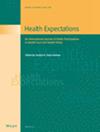Development and Psychometric Testing of EPAT-16: A Short and Valid Measure for Patient-Centeredness From the Patient's Perspective
Abstract
Background
We previously developed the EPAT-64, a patient-reported experience measure designed to assess patient-centeredness (PC) across 16 dimensions of the validated integrative model of PC. While its modular structure makes it highly adaptable to examine certain dimensions of PC, generating an overall PC score requires assessing all 64 items. This is often challenging in routine settings with limited resources. Therefore, we developed and psychometrically tested a 16-item short form.
Methods
We conducted a cross-sectional study involving adult inpatients and outpatients receiving treatment for cardiovascular diseases, cancer, musculoskeletal disorders and mental health conditions in Germany. To ensure comprehensive content coverage, we selected one item per dimension based on content relevance as well as item characteristics such as item difficulty and item-total correlation. We assessed the structural validity of a unidimensional model using confirmatory factor analysis (CFA), measured reliability with McDonald's Omega and evaluated construct validity by investigating the intercorrelation of the EPAT-16 sum score with measures of general health status and satisfaction with care.
Results
All items of the final EPAT-16 showed high acceptability and good item-total correlations, with approximately two-thirds demonstrating appropriate item difficulty. CFA showed a slight misfit of the unidimensional model, but a high average variance explained. McDonald's Omega showed high reliability. All hypotheses about construct validity were confirmed.
Conclusions
The EPAT-16 demonstrated good psychometric properties, making it a feasible tool for assessing overall PC when resource constraints preclude using the full EPAT-64. In particular, it can be used in routine care for feedback and quality improvement, as well as in research to assess relationships with other relevant variables. Since its items were designed generically, it can be used for different medical conditions and settings, for example for public reporting. Future research should evaluate the EPAT-16 in diverse, independent patient samples to confirm that its positive characteristics are consistent across different populations and cultures.
Patient or Public Contribution
Patients did not participate as active members of the research team. However, for the research proposal, several patient organizations provided positive feedback on the study aims and their relevance, signed a collaboration agreement and later supported recruitment by distributing study information.

 求助内容:
求助内容: 应助结果提醒方式:
应助结果提醒方式:


